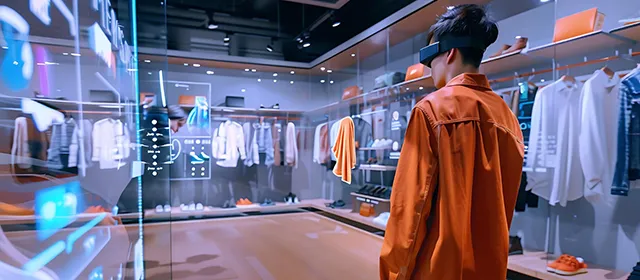Augmented Reality (AR) is transforming how direct-to-consumer (D2C) brands interact with their customers. Rather than relying solely on traditional digital touchpoints, brands are using AR to deliver immersive, personalized experiences that bridge the gap between online shopping and physical retail. This shift holds particular significance for D2C companies, which depend on strong customer engagement, brand loyalty and innovative consumer interactions.
Kings Research that the global augmented reality in retail market is projected to grow from USD 9.11 billion in 2025 to USD 67.73 billion by 2032, exhibiting a CAGR estimatesof 33.19% over the forecast period. This analysis examines how AR is influencing D2C strategies, the technology’s key use cases, leading brand examples and future implications.
Why Do D2C Brands Need Continuous Innovation to Stay Competitive?
Direct-to-consumer brands have grown rapidly in recent years. The U.S. International Trade Commission reports that D2C brands are capturing market share by bypassing traditional retail channels and engaging consumers directly through digital platforms (Source: usitc.gov). This model gives brands more control over the customer experience, pricing and data. However, the competitive pressure is intense, and consumers increasingly demand richer, more interactive shopping journeys.
E-commerce, which powers most D2C operations, continues to grow steadily. The U.S. Census Bureau estimates that in the first quarter of 2025, retail e-commerce sales reached $300.2 billion, accounting for 16.2 percent of total retail sales (Source: census.gov). This growing share underscores both opportunity and necessity: D2C brands must innovate to stand out in a crowded digital marketplace. AR offers one of the most compelling avenues for differentiation, engagement and customer retention.
How Are D2C Brands Using AR to Enhance Customer Experiences?
- Virtual Try-On and Fit Visualization: One of the critical applications of AR for D2C brands is the virtual try-on experiences. Apparel, eyewear and beauty brands can leverage AR to allow consumers to see how products look on them before purchasing. This reduces uncertainty, lowers return rates and strengthens customer confidence. Brands that adopt AR try-on environments can replicate parts of the in-store experience digitally, which is especially valuable for online shoppers who cannot physically touch or try products.
- Interactive Product Customization: AR enables brands to provide real-time customization tools. A customer designing a personalized phone case, handbag or piece of jewellery can use AR to adjust colours, textures or shapes and immediately visualize how those changes will look in real life. This interactive layer enhances the sense of ownership and personal connection, reinforcing the D2C ethos of tailored, consumer-centric products.
- Experiential Marketing and Brand Storytelling: Direct-to-consumer brands thrive on narrative and community. AR can amplify these strengths by creating immersive experiences that tell a product’s story, demonstrate its use, or connect it to the brand’s mission. For example, a skincare brand can provide an AR experience showing how its ingredients work at a cellular level or simulate the impact of regular use. Such storytelling deepens customer engagement, fosters brand loyalty and differentiates D2C offerings from mass-market alternatives.
- Virtually Enhanced Retail Spaces: Some D2C brands maintain pop-up stores or showroom spaces. AR can enrich those physical environments by delivering interactive content, digital product overlays or additional information via smartphones or AR glasses. Customers visiting these curated spaces receive layered experiences product details, usage scenarios or user-generated content that help them make informed purchase decisions.
- Post-Purchase Engagement and Support: AR can support D2C customers post-purchase. Brands can deliver AR-guided assembly, usage instructions or maintenance tips. A furniture D2C brand, for instance, might provide an AR overlay that shows how to assemble or maintain a piece of furniture step by step. This enhances the user experience, reduces customer service costs and increases satisfaction.
- Social Commerce and AR Filters: Many D2C brands rely on social media for discovery and sales. AR filters on platforms like Instagram or Snapchat can allow users to try on products or explore brand-themed virtual environments. These filters generate user-driven content that can go viral, increasing reach at relatively low cost. They also encourage social proof and peer influence, crucial for D2C growth.
Which D2C Brands Are Leading the Way in AR Adoption?
Several D2C brands are already integrating AR into their customer journeys. Warby Parker, the eyewear D2C brand, uses AR in its mobile app to let customers try on frames virtually. This helps reduce returns, supports customer decision-making and leverages the mobile-first behaviour of many online shoppers.
Beauty brand L’Oreal (which operates D2C channels) has launched its “Style My Hair” AR app, enabling consumers to test different hairstyles and hair colour options in real time. This engaging experience supports purchase decisions and drives deeper customer interaction.
Furniture startup IKEA, though not strictly D2C for all products, offers an AR catalog via its IKEA app. Customers can place virtual furniture in their own living spaces to evaluate size, style and fit. This functionality reflects how immersive AR can bridge the gap between digital browsing and physical home environments.
Core Benefits of AR for Direct-to-Consumer Brands
- Lower Return RatesL: Providing try-on or product visualization helps reduce uncertainty. Customers who can virtually test items before buying are less likely to return them. This reduction in returns improves profitability and operational efficiency.
- Improved Conversion Rates: AR helps customers make confident purchase decisions. When shoppers feel more certain about how a product will look or function in the real world, they are more likely to complete a transaction. This drives higher conversion rates for D2C brands that invest in AR experiences.
- Stronger Brand Differentiation: Emergent or niche D2C brands benefit from AR when it reinforces their identity. Brands that emphasize personalized experiences, craftsmanship or innovation gain a competitive edge through immersive, interactive tools.
- Enhanced Customer Retention and Loyalty: AR-based engagement extends beyond checkout. By offering post-purchase AR support, brands maintain contact with customers, increasing satisfaction and reducing support costs. This consistent, value-adding engagement can foster long-term loyalty.
- Cost-Effective Marketing: AR filters and experiences on social media drive organic growth. Users share their AR experiences, effectively becoming brand ambassadors. For D2C brands operating on tight marketing budgets, this word-of-mouth amplification is particularly valuable.
What Challenges Do D2C Brands Face When Implementing AR?
- Technical Complexity and Development Cost: AR development requires specialized skills: 3D modelling, tracking, mobile optimization and UX design. Some D2C brands may find these resources costly or difficult to justify until AR proves its ROI.
- Device Fragmentation and Compatibility: Users access AR on a wide range of devices, from high-end smartphones to older models. Ensuring a consistent, high-quality AR experience across this spectrum requires rigorous testing and optimization.
- User Experience and Adoption Barriers: Some customers may perceive AR tools as gimmicks if they are poorly designed. Designers must ensure that AR experiences are intuitive, useful and aligned with real purchase decisions. Otherwise, users may abandon them.
- Data Privacy and Security: AR apps often require camera access and may collect spatial data about users’ environments. Brands must implement strong privacy safeguards, clearly communicate data use and comply with relevant data protection regulations.
- Measuring ROI: Quantifying the business impact of AR investments remains challenging for many direct-to-consumer brands. Metrics such as increased conversion, reduced returns or enhanced engagement must be tracked and correlated with AR usage to validate investment.
What Strategic Shifts Must D2C Brands Make to Succeed with AR?
Direct-to-consumer brands that invest in AR should develop a clear AR strategy tied to customer journey stages. This strategy must define where AR adds the most value: try-on, visualization, customization or post-purchase support.
Partnerships will be essential. Brands may collaborate with AR-specialized technology companies, 3D-asset providers or mobile-app development firms to accelerate deployment. Outsourcing parts of the AR pipeline can reduce time to market and spread cost risk.
Data strategy must evolve. Brands should collect insights on how customers use AR features, what they try, how long they interact and whether AR engagement links to purchases. These insights inform iteration, personalization and expansion.
Marketing alignment is critical. AR experiences should integrate with social media campaigns, e-commerce platforms and customer support workflows. Brands must promote AR tools to drive adoption and educate consumers about their value.
Future Outlook
Augmented Reality will become increasingly mainstream for D2C brands. As mobile hardware improves and more consumers use AR-capable devices, AR features like try-on, customization and visualization will become expected, not novel.
Artificial intelligence will further enhance AR. Generative models could help create virtual try-on content at scale, enabling near-instant texture mapping and personalized visualizations. AI-driven AR may offer personalized product recommendations based on a customer’s environment or style preferences.
Integration of AR with other immersive technologies, such as mixed reality (MR) or Virtual Reality (VR), will offer deeper engagement. D2C brands could use hybrid experiences to simulate product usage in a user’s real-world context or blend real and virtual showrooms.
Strategic use of AR in supply chain and operations may emerge. Brands may develop AR-based tools for warehouse picking, quality control, or logistics, bridging consumer experience with back-end efficiency. This could create operational value beyond customer-facing benefits.
Conclusion
Augmented Reality is poised to transform how direct-to-consumer brands interact with their customers. AR’s capacity to deliver virtual try-ons, product customization, immersive storytelling and post-purchase support aligns closely with the D2C model’s priorities. Leading brands already leverage AR to differentiate, engage and retain customers.
Challenges remain in development cost, user adoption and measurement. However, strategic investments in AR infrastructure, data insights and partnerships will likely generate significant returns. The next generation of D2C brands that embed AR in their core customer experience will gain a competitive edge, offering richer, more confident and more engaging shopping journeys.




